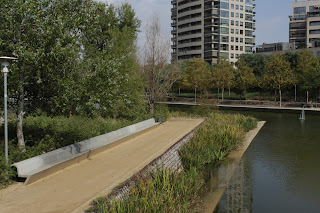Monday, November 19, 2012
Saturday, November 17, 2012
Program
The gate as transition
We propose to create a physical transition between the urban and the green landscape and a conceptual transition between dreamworld(camino) and the real world. The traditional citygate is an inspiration for the project. In the existing site there is a number of layers progressing from the urban public space (the street, the park), the private(the house), into the semiprivate(the backyard) and finally into the semipublic(the square).
This creates a new ”citywall” that cuts off the outer periphery where the camino runs from the countryside to the city. As there already exists an opening into the city adjacent ot our site, we hope to create more of a doorway, an alternative ”labyrinthine” connection with the urban fabric.
The labyrinth as camino
The maze which sits immediately in front of our site is a symbol not just the fabric of the city of Santiago, but also a microcosm of the topography and circulation in the immediate context of our site. The labyrinth is an ancient symbol that is connected with the pagan galician mythology as well as with cristian symbolism and ultimately the camino (and as a labirynthine spiral with the universe in general). The camino is a place to be lost and found spiritually, although you always see the signs of the route, just as in a labirynth you see the walls, without knowing exactly where you are. In this way, the labyrinth is used both in group (social) rituals and in individual meditation. We want our albergue to play along the rules of the labirynth, not to get lost but to extend the experience of moving between its functions.
Site as verticality in form of staircases.
From wikipedia:
” Some books (guidebooks in particular) suggest that mazes on cathedral floors originated in the medieval period as alternatives to pilgrimage to the Holy Land, but the earliest attested use of the phrase "chemin de Jerusalem" (path to Jerusalem) dates to the late 18th century when it was used to describe mazes at Reims and Saint-Omer.[30] The accompanying ritual, depicted in Romantic illustrations as involving pilgrims following the maze on their knees while praying, may have been practiced at Chartres during the 17th century. [30] ”
We propose to create a physical transition between the urban and the green landscape and a conceptual transition between dreamworld(camino) and the real world. The traditional citygate is an inspiration for the project. In the existing site there is a number of layers progressing from the urban public space (the street, the park), the private(the house), into the semiprivate(the backyard) and finally into the semipublic(the square).
This creates a new ”citywall” that cuts off the outer periphery where the camino runs from the countryside to the city. As there already exists an opening into the city adjacent ot our site, we hope to create more of a doorway, an alternative ”labyrinthine” connection with the urban fabric.
The labyrinth as camino
The maze which sits immediately in front of our site is a symbol not just the fabric of the city of Santiago, but also a microcosm of the topography and circulation in the immediate context of our site. The labyrinth is an ancient symbol that is connected with the pagan galician mythology as well as with cristian symbolism and ultimately the camino (and as a labirynthine spiral with the universe in general). The camino is a place to be lost and found spiritually, although you always see the signs of the route, just as in a labirynth you see the walls, without knowing exactly where you are. In this way, the labyrinth is used both in group (social) rituals and in individual meditation. We want our albergue to play along the rules of the labirynth, not to get lost but to extend the experience of moving between its functions.
Site as verticality in form of staircases.
From wikipedia:
” Some books (guidebooks in particular) suggest that mazes on cathedral floors originated in the medieval period as alternatives to pilgrimage to the Holy Land, but the earliest attested use of the phrase "chemin de Jerusalem" (path to Jerusalem) dates to the late 18th century when it was used to describe mazes at Reims and Saint-Omer.[30] The accompanying ritual, depicted in Romantic illustrations as involving pilgrims following the maze on their knees while praying, may have been practiced at Chartres during the 17th century. [30] ”
http://en.wikipedia.org/wiki/Labyrinth
Preparation for return to everyday life:
The sleep as starbathing?
Isolated dark sleeping units, connected to the skyscape.
The possibility to stay longer in Santiago Compostela, to slowly wind through your experiences from the walk. Also increased number of nights spent on reflection of the camino walked.
The possibility to stay longer in Santiago Compostela, to slowly wind through your experiences from the walk. Also increased number of nights spent on reflection of the camino walked.
Subscribe to:
Comments (Atom)
































